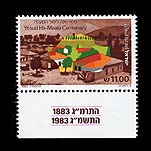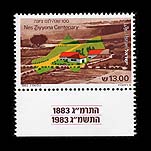|
A century ago, in 1883, Yesud Ha-maala was founded. Bordering the Huleh swamps, in one of the wildest areas of Palestine of a hundred years back, a group of Polish Zionists from the town of Mezirech made their home here. They bought the land from a Jewish family from Safed who had cultivated it for eleven years, and named it Yesud Ha-Maa Ia, or the Beginning of the Ascent, from Ezra 7:9, "For upon the first day of Pie first month began he to go up from Babylon."
The pioneers lived in reed huts on the edge of the marshes, and conditions were unspeakably harsh. Malaria, marauding Bedouin, flooding and their own inadequate farming knowledge plagued the settlers, but they were determined never to give up.
In 1900 Baron Edmund de Rothschild included Yesud Ha-Maala in the villages he sponsored, but with little result. Projects like the introduction of mulberry trees for silkworm breeding were unsuccessful, and the colonists subsisted on unirrigated grain crops until the 1940s, when PICA - the Palestine Jewish Colonization Association - extended extra aid.
A company of energetic youngsters from moshavim, known as Bnei Pele, joined Yesud Ha-Maala, and after the War of Independence their numbers were strengthened by new immigrants. Drainage of the Huleh in the 1950s changed the macro-environment of the settlement, and its inhabitants obtained more farmland and workable fields. Today its 550 people work 8,000 dunams of land, and their economy includes vegetable and fruit growing and fisheries. Another source of income stems from the fact that Yesud Ha-Maala is the starting-point for excursions to the Huleh Nature Reserve. Yesud Ha-Maala's shield-shaped emblem depicts, on three separate sections, a homestead, orchards and swamps.
Nes Ziyyona is a thriving townlet on Israel's coastal plain between Rehovot and Rishon le Zion. Basically agricultural, with citriculture providing regular and seasonal work, it also produces honey, for which the area is noted. Over the years industries were developed, and include factories making ceramics, fibreglass, electrical goods and other items. Another important source of employment is the recently established Centre for Biological Research.
One of the earliest settlements in the country, Nes Ziyyona was founded in 1883, and its century-long story is unusual and interesting. It was originally an Arab hamlet, Wadi Hanin or Valley of Roses, where in 1878 a German Templar named Reisler bought an orange orchard and built himself a house in its midst.
On a visit to Russia, Reisler chanced to meet an orthodox Zionist, Reuben Lehrer, who agreed to exchange his Russian homestead for that in Wadi Hanin. In 1883 he arrived to take possession of his property and called it Nahlat Reuben. Soon a few Jewish labourers joined him. Houses were erected, and the little colony lived happily while endeavouring to fulfil Reuben Lehrers aim to have at least ten men for a minyan, or ritual quorum.
Nes Ziyyona received its present name - a Standard toward Zion from the command in Jeremiah 4:6 to Set up the standard toward Zion,' when in the 1890's the blue-and-white banner was unfurled in defiance of the Turkish authorities. Its pleasant atmosphere attracted Jews and Arabs, and it was almost the only village where both lived in harmony, each keeping to their own side of the main road! After the War of Independence the Arabs left, while about 2,000 Jews remained. Nes Ziyyona quickly began to expand. New suburbs sprang up, and today Nes Ziyyona is an agreeable township of 14,000 souls. Its emblem shows the national flag above a clover-leaf displaying bees, citrus fruit and light industry.


